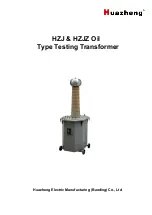
ENC-900 Operating Manual: Chapter 4 Configuration
37
4.4.3 Remote Control and Diagnostics (S101=5)
This is a very powerful tool which allows user to remotely configure and
interrogate all units in a multipoint system from the Master unit. Simply by
having knowledge of the unit address of each Remote/repeater in the
system, users can set the unit address of the master to match that of the
Remote/repeater of interest, set S101=5, go online, and interrogate/modify
virtually all parameters of the remote repeater/Remote unit. It should be
noted that when the master goes online, all other units belonging to the
network will synchronize with the master, but only the unit whose unit
address matches the master’s will respond to the master’s diagnostic
commands.
In addition, in diagnostics mode, the master can change its unit address ‘on-
the-fly,’ avoiding the delays of going into command mode, modifying the
unit address, going back online and re-synchronizing with the entire
network, before interrogating a new Remote/repeater. The master’s unit
address can be changed while still maintaining synchronization with the
entire network, allowing for quick and efficient diagnostic sessions with all
remote units. Ensure that register S122=1 on any Remote/repeater that you
wish to remotely modify.
Table 4 provides a diagnostics command summary. The first column is a
list of commands that may be issued at the master. The second column is
the corresponding remote register. In general, any command issued without
any additional parameters is a read command. For example, if you type:
0
<return>
The remote Remote/repeater will send back the value if its S101 register.
On the Master terminal screen, you would see:
0 (this is the 0 that you typed, echoed back locally)
3 (this indicates that the remote’s S101=3)
If you type:
04
<return>
This command would change the remote’s operating mode to S101=4
(repeater). The remote unit should return ‘OK’. Remember, if the remote’s
S122=0 (remote control disabled), the remote will respond with ‘ERROR’.
In Table 4, Column 1, the meanings of the format is as follows:
COMMAND
A command without (x) indicates that you may not add any
additional parameters. i.e., you may only read back the value
of the remote’s register. You may not modify that register.
The only exception to this is the WRITE command ‘e’. Type
‘e’ to force the write command (&W) at the remote modem.
COMMAND(x)
Indicates this command may be sent with or without a
parameter. Issuing this command without a parameter reads
the corresponding remote’s register. Issuing this command
with the additional parameter ‘x’ changes the corresponding
remote’s register to ‘x’. Remember, any changes you wish to
retain in the event of a power down or reset should be stored to
non-volatile memory by issuing the write command ‘e’.
Summary of Contents for ENC-900
Page 9: ...ENC 900 Operating Manual Chapter 2 Electrical Physical 5 ...
Page 17: ...ENC 900 Operating Manual Chapter 2 Electrical Physical 13 ...
Page 44: ...40 ENC 900 Operating Manual Chapter 4 Configuration ...
Page 46: ...42 ENC 900 Operating Manual Appendix A Modem Command Summary ...
Page 48: ...44 ENC 900 Operating Manual Appendix B Factory Default Settings ...
Page 50: ...46 ENC 900 Operating Manual Appendix C Technical Specifications ...
Page 54: ...50 ENC 900 Operating Manual Appendix E Approved Antennas ...














































